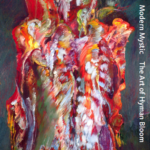Spring 2020 The Maine Arts Journal
Comparisons to James Ensor, Chaim Soutine, and Matthias Grünewald put him firmly in a tradition of an unflinching gaze. Bloom’s intent was not to explain his work but to lead the viewer more deeply into the paintings.
The way I see it, Bloom’s paintings are mandalas. They are maps to the universe and keys to spiritual experiences akin to the ones which started Bloom’s career…They weave together shattered objects into dense, unbroken tapestries.
Each painting is a step on a quixotic quest: capturing the universe in a single canvas.
Bloom moves from the phenomenal subject, transforming the language of its description to reveal an otherwise invisible essence: the spirit in the body; new life regenerating from the dead, a continual metamorphosis…[These works demonstrate] Bloom’s currency with the most advanced pictorial ideas of mid-century. It took courage, perseverance and a great depth of spiritual feeling to produce these works, which live in us by the emotions they communicate. As I left this exhibition I was filled, with a sense of doubt that a true history of American art of the last seventy years has been written.
…no art past or present looks like Hyman Bloom’s. He’s a solitary wonder. His apartness continues to be a liability to his placement in our history, but it is a great, great blessing for us all.
Holland Cotter, NY Times Senior Art Critic, at the Boston MFA Symposium
The show is titled “Hyman Bloom: Matters of Life and Death,” and Bloom announces himself there, from beyond the grave, as one of the greatest American artists of the 20th century and just the kind of seer we need.
Fellow artists could see how original and brilliant Bloom was—Jackson Pollock and Willem de Kooning famously considered him the “first abstract expressionist,” and for a short time he was fêted alongside them. He never became anything like a household name, though, and his prices never vaguely approached those of his famous admirers. But stand in front of his work: It easily equals theirs in terms of power, virtuosity, and originality.
Seeing one of Bloom’s paintings in person is an experience not soon forgotten. He layered thick paint in jewel-like tones…No painter’s work has ever taken more restraint to not touch.
There’s so much to say about Bloom’s incredibly vital paintings. However, I wouldn’t have to say anything if they were treated as they should be: hanging in the world’s most prestigious museums alongside peers Goya, Lucian Freud, Francis Bacon, and above all Rembrandt and Chaim Soutine.
…his paintings are really about the redemption and transformation of flesh and gross matter into transcendent spiritual fire. Bloom smashes open the human body to reveal that its veins and organs are glowing wings and feathery flows ablaze and humming with mystical significance.
10/01/2019 The Burlington Magazine (subscription required)
Exhibition Review
In his lifelong pursuit of meaning, he turned to Judaism, Rosicrucianism, astrology, theosophy, Indian philosophy and psychoanalysis. Such investigations underscore images that convey the transcendental, mystical and spiritual. To paraphrase the curator Frederick Wright: ‘What he chose to paint is not visible’.
09/23/19 Art in America(subscription required)
Along with the MFA show and “Modern Mystic”, an exhibition of his paintings at Alexandre Gallery in New York…confirms the continuing power of his themes: the vulnerability of flesh, the exploration of the spiritual through art, and the conviction that change is the essence of reality.
08/23/19 The Week(subscription required)
The MFA’s current show proves he should be counted among our 20th-century masters.
08/22/19 The New Criterion
Nowadays art can hardly be literal enough for some people….In comparison, Bloom’s work looks like poetry itself….the kind of excavation of the soul that we see in Bloom has become a rarity and an exception in a world given over to mere display.
08/18/19 jeanninecook.com
The overall impression I gained was of a superbly gifted artist whose questing spirit and deep interest in all aspects of life and death, and the innate beauty one can find at every stage throughout life, pushed him ever onwards to explore and celebrate.
…Bloom ranks among the greatest American artists of the 20th century
…the current exhibition of Bloom’s work makes a compelling argument for revisiting his dark yet compelling oeuvre, showcasing the artist’s skill as a draftsman, his struggles with spirituality, and his deep-seated fascination with the human body.
He engaged in deep, spirited conversations with artists such as Rembrandt, Soutine, and Odilon Redon, taking inspiration from them and making something all his own.
…a master painter in supreme balance between intention and emotion, tracking both on the canvas in deliberate, exuberant strokes.
…one of the most extraordinary and disturbingly beautiful bodies of work in American art.
One of the most important shows nationally this year: Hyman Bloom.
-Sebastian Smee, Washington Post, on Twitter
07/30/19 NY ArtNews
The original drive that brought the work to life creates a new experience for each viewer, encouraging them to shape a deeper meaning.
One of the most important artists and a predecessor to the championing Abstract Expressionists…
The art world, with its fast pace, ongoing turnover of interests, and voguish audiences, never held him. He always knew he was an anomaly. His only satisfaction was to mine the possibility for an art that could transcend temporal boundaries by alluding to a world beyond the material.
Bloom’s paintings often represent moments when, in his own words, “the mood is as intense as it can be made,” which ends up looking like some meeting of the corporeal and the cosmic. What is earthly, and what is ethereal? Bodies swim into blurs. Horizons melt like heated plastic. Blobs bristle with tooth and bone.


